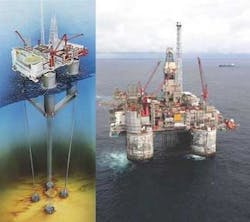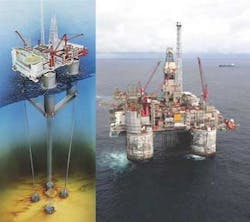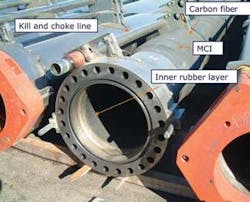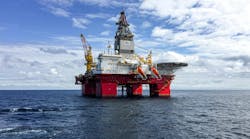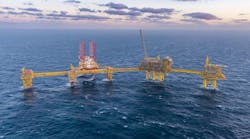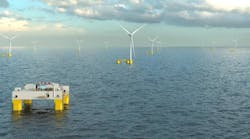Bjørn Melve, Petter Fjellheim, Stig Raudeberg, Siv Arna Tanem - StatoilHydro ASA
Demand for strong yet lightweight materials able to stand up to the harsh subsea environment has spiked, with a corresponding peak of interest in composites. Composite risers have been an aim because they can offer real performance benefits vs. traditional steel, especially as offshore production moves to deeper water. Major players in the oil and gas industry have been at work on risers, including StatoilHydro, Shell, Conoco, AKS, Saga Petroleum, Seaflex, Raufoss, ABB (now GE VetcoGray), and IFP, which developed composite choke and kill lines more than 20 years ago.
Merging riser projects
A project to make a composite workover riser began in Norway in the mid-1990s. The participants were the engineering company Seaflex and the composite manufacturer Raufoss. The project was sponsored by Statoil initially and later got support from Hydro, Saga Petroleum, and Shell. The project received funding from the Norwegian Research Council.
At the same time, Norske Conoco initiated a project to make a drilling riser joint that could fit into the drilling riser string on theHeidrun TLP. Norske Conoco was operator in the building phase of Heidrun. Statoil took over as operator in the production phase and agreed to install the riser joint once it was available. Norske Conoco later formed a strategic alliance with Kvaerner (later Aker Kvaerner) who also became a partner.
The motivations for introducing the composite material drilling riser joint included:
- To lower weight compared to titanium
- To prove that it was possible to make a cost-efficient composite material riser.
The design contract for the riser joint went to Lincoln Composites, which was involved in a US government sponsored program to develop composite material risers. The “trap-lock” design for the metal to composite interface (MCI) was developed as a part of this program. Fatigue tests were done to support the design work and to verify the fatigue properties of the composite material.
The joint was designed to match the properties of titanium joints. The end connections were made in titanium to provide an easy interface. A liner of titanium inside the riser joint avoids any corrosion.
The workover riser project and the drilling riser project were merged since many of the participants were involved in both projects.
The Compriser project
The merged project was named “Compriser.” Norske Conoco AS, Kvaerner Oilfield Products (KOP - later Aker Kvaerner), Statoil, Chevron, Shell, Petrobras, and Norsk Hydro were participants and sponsors. The project also received support through the EU Thermie program.
The result was the first implementation of an offshore composite drilling riser joint with carbon fiber in the main structural body and titanium end flanges at theHeidrun TLP in 2001. The joint has an internal titanium liner.
The composite riser joint has an internal diameter of 560 mm (22 in.), is 15 m (48 ft) long, and a part of the marine riser. The joint has been in service for six years and has been treated as its metallic counterparts. After 16 drilling campaigns, no change in the properties of the joint during service through inspection and pressure testing has been seen.
The prototype joints were manufactured by Lincoln Composites. The fatigue testing was performed by the Oil States laboratory in Aberdeen. Spencer Composites produced the subsequent prototype test joints. The production joint that was delivered toHeidrun also was produced by Spencer Composites.
Det Norske Veritas (DNV) verified the design and witnessed the testing. DNV inspected the joint before and after factory acceptance testing.
Compriser joint details
The end of the Compriser joint has an attached auxiliary line, internal rubber layer, composite wall, and MCI.
The different layers of the wall of the composite riser joint from the inside to the outside are:
- Internal rubber liner to protect the metallic liner from the drillstring interaction
- Titanium liner for hydrocarbon tightness
- Interface shear layer from rubber
- Composite material structural wall
- External rubber for impact protection and external pressure containment
- External glass fiber/epoxy wear layer.
The final joint satisfied all the design and test requirements for installation at theHeidrun TLP.
Inspection program
Due to the multilayered structure of the joint wall, in-service inspection (non destructive evaluation) of the joint is challenging.
NDE-methods often used for inspection of composites include:
- Visual / penetrates
- Ultrasound
- Radiographic
- Tomographic
- Acoustic emission
- Thermography
- Microwaves
- Holographic methods, shearography.
Since the wall is a combination of metallic materials, rubber, and composites, most standard methods such as ultrasound and radiography are not easy to apply.
The most promising method to inspect all layers at once would be the use of computer tomography (CT). CT inspection would be easiest on the straight section of the joint. The area of the joint with the highest stresses is the metal to composite interface. Here the thick metallic wall will complicate the sensitivity of the CT imaging when looking for cracks in the composite material.
Based on an evaluation of inspection methods available for field application, the following scheme was established:
- External visual inspection
- Pressure testing for leak tightness
- Measurement of overall elongation during pressure testing to verify the composite wall
- Measurement of volumetric expansion during pressure testing
- Internal visual inspection of the rubber layer
- Eddy current check for cracks in the titanium liner.
Inspections were done at the following points:
- During factory acceptance testing
- After shipment to Norway with rubber liner in place
- Same time with rubber liner removed
- Between drilling operations (at intervals).
An alternative approach was used for the production riser joints later made for theMagnolia TLP. The production joint was equipped with a double metallic liner so that the annulus between the liners could be used to detect any leaks before break.
Service, inspection history
The Compriser project continued until the autumn of 2002. The riser joint at that time had been used at different locations in the drill string. After an inspection, the riser joint was formally taken over by the Heidrun license.
Visual inspection of the drilling riser joint at the supply base in Kristiansund in the summer of 2005 indicated only minor scratches in the external glass fiber epoxy layer resulting from the tools used on the drilling deck during operations. The marks may have been there from the first drilling campaign.
The internal titanium liner was checked with eddy current and was found to be without faults. DNV performed a pressure test. The same methodology and equipment was used to measure the elongation and volume expansion during pressure testing for all inspections. The axial strain at a reference pressure of 320 bar (4600 psi) for the different inspections indicated no change in the stiffness during use. Initially there was some concern whether the internal rubber liner would contribute to the axial stiffness, but this was shown not to be the case.
Success factors
The most important success factor was that the Heidrun drilling department was involved in the introduction of this new technology. Those individuals closely followed the final stages of the Compriser project. They also witnessed the production and the acceptance testing of the production joint.
The importance of having “champions” within the organization receiving new technology proved to be of great importance when there were some technical set-backs late in the project.
In the final license partner meeting the direct involvement of the drilling department made it easy for the partners to agree on testing out this new technology.
The way forward
The logical extension of the Compriser project was taken forward with the production risers for theMagnolia TLP. The dimensions were 11 ¾ in. (30 cm) and steel replaced the titanium parts. The joints were qualified according to the requirements, but the joints were not installed due to challenges in the manufacturing. Subsequent composite riser initiatives include:
- Vetco is developing a continuous reelable composite riser
- IFP is developing an externally wrapped hybrid riser. This concept is now a RPSEA initiative.
Due to the more demanding riser application in ultra deepwater, composite riser can be cost-efficient for top-tension risers. Two areas have potential:
- Deepwater drilling riser for high-pressure reservoirs
- Light-weight sections in different configuration for steel catenary production risers.
Since the joints discussed here has metallic end section, standard welding techniques can be used to fit in sections of lightweight composite sections as integral part of the SCR. This can be used to optimize the configuration for a deepwater riser. Installation would be by tow out or by J-lay.
Acknowledgement
The authors acknowledge the support from the Compriser project with its major sponsor ConocoPhillips and Aker Kvaerner.
